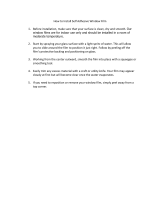
Installation & Owner’s Guide 13a
120V
Size Amps Watts Low Limit Nominal High Limit
1.5x1 0.15 18 760.00 800.00 880.00
1.5x2 0.3 36 380.00 400.00 440.00
1.5x3 0.45 54 253.33 266.67 293.33
1.5x4 0.6 72 190.00 200.00 220.00
1.5x5 0.75 90 152.00 160.00 176.00
1.5x6 0.9 108 126.67 133.33 146.67
1.5x7 1.05 126 108.57 114.29 125.71
1.5x8 1.2 144 95.00 100.00 110.00
1.5x9 1.35 162 84.44 88.89 97.78
1.5x10 1.5 180 76.00 80.00 88.00
1.5x11 1.65 198 69.09 72.73 80.00
1.5x12 1.8 216 63.33 66.67 73.33
1.5x13 1.95 234 58.46 61.54 67.69
1.5x14 2.1 252 54.29 57.14 62.86
1.5x15 2.25 270 50.67 53.33 58.67
1.5x16 2.4 288 47.50 50.00 55.00
1.5x17 2.55 306 44.71 47.06 51.76
1.5x18 2.7 324 42.22 44.44 48.89
1.5x19 2.85 342 40.00 42.11 46.32
1.5x20 3 360 38.00 40.00 44.00
3x1 0.3 36 380.00 400.00 440.00
3x2 0.6 72 190.00 200.00 220.00
3x3 0.9 108 126.67 133.33 146.67
3x4 1.2 144 95.00 100.00 110.00
3x5 1.5 180 76.00 80.00 88.00
3x6 1.8 216 63.33 66.67 73.33
3x7 2.1 252 54.29 57.14 62.86
3x8 2.4 288 47.50 50.00 55.00
3x9 2.7 324 42.22 44.44 48.89
3x10 3 360 38.00 40.00 44.00
3x11 3.3 396 34.55 36.36 40.00
3x12 3.6 432 31.67 33.33 36.67
3x13 3.9 468 29.23 30.77 33.85
3x14 4.2 504 27.14 28.57 31.43
3x15 4.5 540 25.33 26.67 29.33
3x16 4.8 576 23.75 25.00 27.50
3x17 5.1 612 22.35 23.53 25.88
3x18 5.4 648 21.11 22.22 24.44
3x19 5.7 684 20.00 21.05 23.16
3x20 6 720 19.00 20.00 22.00
3x21 6.3 756 18.10 19.05 20.95
3x22 6.6 792 17.27 18.18 20.00
3x23 6.9 828 16.52 17.39 19.13
3x24 7.2 864 15.83 16.67 18.33
3x25 7.5 900 15.20 16.00 17.60
240V
Size Amps Watts Low Limit Nominal High Limit
1.5x1 0.075 18 3040.00 3200.00 3520.00
1.5x2 0.15 36 1520.00 1600.00 1760.00
1.5x3 0.225 54 1013.33 1066.67 1173.33
1.5x4 0.3 72 760.00 800.00 880.00
1.5x5 0.375 90 608.00 640.00 704.00
1.5x6 0.45 108 506.67 533.33 586.67
1.5x7 0.525 126 434.29 457.14 502.86
1.5x8 0.6 144 380.00 400.00 440.00
1.5x9 0.675 162 337.78 355.56 391.11
1.5x10 0.75 180 304.00 320.00 352.00
1.5x11 0.825 198 276.36 290.91 320.00
1.5x12 0.9 216 253.33 266.67 293.33
1.5x13 0.975 234 233.85 246.15 270.77
1.5x14 1.05 252 217.14 228.57 251.43
1.5x15 1.125 270 202.67 213.33 234.67
1.5x16 1.2 288 190.00 200.00 220.00
1.5x17 1.275 306 178.82 188.24 207.06
1.5x18 1.35 324 168.89 177.78 195.56
1.5x19 1.425 342 160.00 168.42 185.26
1.5x20 1.5 360 152.00 160.00 176.00
3x1 0.15 36 1520.00 1600.00 1760.00
3x2 0.3 72 760.00 800.00 880.00
3x3 0.45 108 506.67 533.33 586.67
3x4 0.6 144 380.00 400.00 440.00
3x5 0.75 180 304.00 320.00 352.00
3x6 0.9 216 253.33 266.67 293.33
3x7 1.05 252 217.14 228.57 251.43
3x8 1.2 288 190.00 200.00 220.00
3x9 1.35 324 168.89 177.78 195.56
3x10 1.5 360 152.00 160.00 176.00
3x11 1.65 396 138.18 145.45 160.00
3x12 1.8 432 126.67 133.33 146.67
3x13 1.95 468 116.92 123.08 135.38
3x14 2.1 504 108.57 114.29 125.71
3x15 2.25 540 101.33 106.67 117.33
3x16 2.4 576 95.00 100.00 110.00
3x17 2.55 612 89.41 94.12 103.53
3x18 2.7 648 84.44 88.89 97.78
3x19 2.85 684 80.00 84.21 92.63
3x20 3 720 76.00 80.00 88.00
3x21 3.15 756 72.38 76.19 83.81
3x22 3.3 792 69.09 72.73 80.00
3x23 3.45 828 66.09 69.57 76.52
3x24 3.6 864 63.33 66.67 73.33
3x25 3.75 900 60.80 64.00 70.40
Resistance (Ohms) Resistance (Ohms)

























